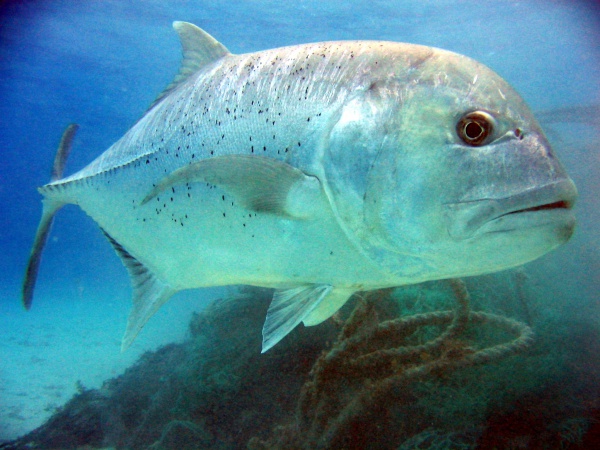Facts About Giant trevally
The giant trevally, also known by various regional names such as barrier trevally, giant kingfish, or ulua, is a large and formidable fish belonging to the jack family, Carangidae. These fish inhabit the warm tropical waters of the Indo-Pacific, ranging from South Africa to Hawaii, Japan, and Australia. They are easily identifiable by their steep head profile, robust tail scutes, and silvery bodies often marked with dark spots. Intriguingly, mature males frequently turn black. As the largest member of the Caranx genus, they can reach lengths of up to 170 cm and weigh as much as 80 kg.
Giant trevallies begin their lives in estuaries and shallow bays, but as they age, they migrate to deeper reefs and offshore atolls. As apex predators, their diet is diverse, including fish, crustaceans, cephalopods, and mollusks. They are renowned for their sophisticated hunting techniques, such as trailing monk seals and utilizing sharks to ambush their prey. Spawning occurs during the warmer months and is often correlated with lunar cycles.
These fish are highly valued by both commercial and recreational fisheries. They are typically captured using nets, lines, bait, and lures. However, consuming them can sometimes result in ciguatera poisoning, a type of food poisoning caused by toxins in the fish.
Scientifically, the giant trevally is part of the Carangidae family and the Carangiformes order. It was first described in 1775 by Peter Forsskål and has undergone several reclassifications since. Known by various names depending on the region, giant trevallies inhabit a wide range of environments, from shallow coastal waters to deep reefs, and can even be found in estuaries and rivers, demonstrating remarkable tolerance for varying salinity levels.
Behaviorally, adult giant trevallies are generally solitary but will form schools for reproduction. They exhibit varied feeding habits and employ both individual and group hunting strategies, with some even observed stealing prey from monk seals. They reach sexual maturity around three years of age and spawn in specific locations during warmer months. Their larval stages and growth patterns have been extensively studied.
Culturally, the giant trevally holds significant importance, particularly in Hawaiian culture, where it is both revered and highly sought after for food and sport fishing. Commercially, they are captured using a variety of methods and are a favorite among anglers for their strength and speed. Due to declining populations, especially in regions like Hawaii, conservation efforts are increasing. Practices such as catch and release are encouraged to help preserve the species, and some fishing operators are actively tagging the fish for scientific research.
